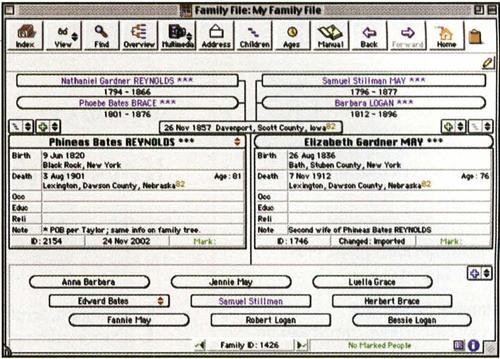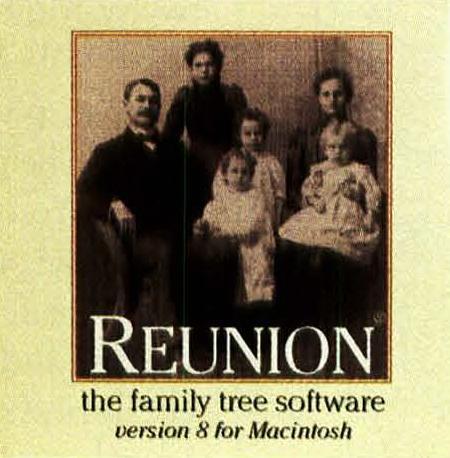Sign up for the Family Tree Newsletter Plus, you’ll receive our 10 Essential Genealogy Research Forms PDF as a special thank you!
Get Your Free Genealogy Forms
"*" indicates required fields

After nearly two decades of using a Macintosh computer, I am used to slim pickings — software, hardware and everything-in-between-ware are all in far shorter supply than the plethora of programs my PC-driving friends are accustomed to. It’s no surprise, then, that genealogy software for the Mac is sparse, as well. Of course, you will find a handful of shareware programs out there — some of them pretty darn nice. And then there’s Leister Productions’ Reunion.
Now weighing in at version 8, Reunion is virtually the only commercial genealogy software for the Mac. That’s OK, though. Reunion’s quality is impeccable, and it’s unbelievably easy to use. Plus, this new version debuts additional chart-editing capabilities, search options and dozens of other improvements. It even gives OS X and earlier Mac platforms their own distinct-but-identical applications. I have a hard time imagining a better program.
The first thing you notice about Reunion is that there’s not much to it: a zip-open cardboard sleeve containing a single CD-ROM. No documentation, except for the installation instructions. It’s fast; it’s complete. And, hey, if we wanted to read software manuals, we’d have bought PCs.
Entering data into Reunion is a snap — whether you’re importing existing GED-COM, text or Reunion files, or building your family file from the ground up. The interface is the familiar “card” system: boys on the left and girls on the right, with vital stats and life events under each person’s name. Parents appear above their children, and children toward the bottom of the screen.
Navigating Reunion is a dream. Everything on the screen is clickable: When you tap an item, the software will either take you to a card or give you a pop-up menu of options. The toolbar at the top of the screen lets you quickly navigate the entire family file; you can drag-and-drop people or families to a Quickbar for customized navigation. The program is surprisingly fast, even on my long-in-the-tooth Power PC Mac clone — click on a button, and there you are.
Reunion is straightforward, but it has some neat subtleties, too. For instance, your male ancestors’ names appear in slightly rounded rectangles; your female ancestors’ name buttons are noticeably more rounded. This graphic device is helpful when you traipse back a millennium or so and come up against the likes of a Domangart or a Fedelm. No more than a glance is needed to remind you how many X chromosomes they were packing. Similarly, the appearance of tiny red arrows next to an individual’s name shows that he or she had multiple spouses — and a click on the arrows pops up a menu that takes you straight to the spouses’ cards.
Speaking of those cards, all of them except Family File have a gold question mark in the lower left corner. Clicking it will bring up the applicable “page” in Reunion’s extensive and well-written electronic manual. Like the rest of Reunion, the manual is logically organized and highly graphic.
Once you’ve entered data, Reunion gives you numerous options for displays, reports and charts. And, of course, it enables you to export records as text or GEDCOM. Reunion automates HTML conversion for Web publishing, too. You have several options for referencing sources and keeping track of data and questions. In all, Reunion gives you astonishing flexibility for organizing and displaying family information.
Does Reunion give users anything to grouse about? Based on genealogy shareware I’ve used, my instinct is to click on a person’s name to enter marriage information. In Reunion, doing that brings up the Edit Person card, which gives you all sorts of opportunities to enter events, facts, and notes for that individual — but individual is the key word here. To find team efforts, such as marriage, you’ll have to use a different route — namely, clicking a button centered above a couple’s names. But that button is unlabeled until you fill in the marriage information (after which it displays that information), so clicking on it isn’t intuitive. I’d prefer a placeholder label — Marriage, say — instead of a blank button.
But that’s just a quibble — the simple truth is that Reunion is a pleasure to work with, well-thought-out and well-executed. If you have a Macintosh and a family, Reunion is the way to go.
You can order Reunion 8 for $99.95 from any major Mac catalog (see <www.leisterpro.com> for details). Or you can upgrade for $59. Contact Leister Productions at Box 289, Mechanicsburg, PA 17055, (717) 697-1378 or online.
ADVERTISEMENT


